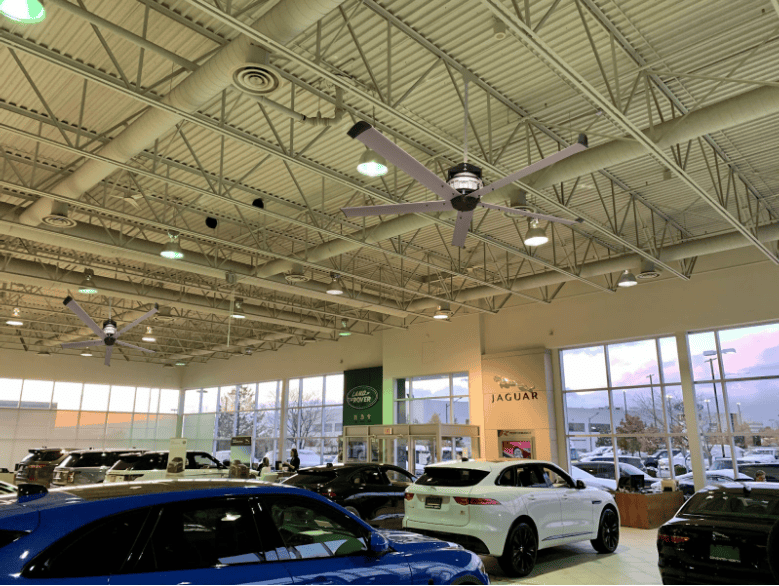
Maintaining a comfortable climate over broad areas in industrial settings such as factories, warehouses, and commercial buildings necessitates a concerted effort. Combining air conditioners, evaporative cooling systems, and HVLS fans can accomplish effective and efficient climate management. This blog talks about the key roles and benefits of HVLS fans, the mechanics of evaporative cooling systems, and how air conditioning systems complement these technologies. We’ll emphasize the interplay of heating, cooling, and ventilation to show how these components work together to provide effective climate control.
The Role and Benefits of HVLS Fans in Air Conditioning
HVLS fans are essential for regulating temperatures in large spaces. With their ability to gently circulate large volumes of air, these enormous ceiling fans enhance comfort and air quality in large workspaces. HVLS fans smoothly and significantly increase airflow, which helps maintain comfortable temperatures for both heating and cooling while easily adjusting to seasonal variations. They accomplish this by effectively eliminating extra heat or making sure that vast regions are evenly heated.
These fans maximize air movement, which can significantly reduce the energy consumption of heating and cooling equipment, leading to lower operational costs. By enhancing the energy efficiency of existing HVAC systems without increasing power consumption, HVLS fans play a vital role in the future of climate control. For instance, the U.S. Department of Energy states that you can save 3-6% on energy costs for every degree of thermostat offset facilitated by fans.
Evaporative Cooling Systems
Evaporative cooling systems use the simple yet effective principle of evaporation to cool air. As warm air passes over water-saturated surfaces, the water evaporates, absorbing heat and lowering the air temperature. The cooled air is then circulated, providing a temperature drop of 10-15 degrees. This type of cooling is especially effective in arid regions with low humidity, consuming less energy and being more cost-effective compared to traditional cooling methods.
Evaporative coolers are greener alternatives to air conditioners, which use compressors and chemical refrigerants. They also moisten the air, which is good for dry conditions. In addition to increasing energy efficiency, this technique recycles fresh air instead of recycled stale air.
The Functionality of Modern A/C Systems
Modern air conditioning systems effectively cool and dehumidify indoor air by removing heat and moisture. This process involves a continuous cycle where refrigerants absorb indoor heat and release it outside, maintaining the desired indoor temperature. Key components like the compressor, condenser, expansion valve, and evaporator work together harmoniously to facilitate efficient heat exchange.
Technological advancements have led to newer A/C models that use less energy and have a reduced environmental impact, addressing concerns about energy consumption and environmental effects. These innovations lower operational costs and enhance sustainability by decreasing the carbon footprint associated with cooling. When combined with HVLS fans and evaporative cooling systems, A/C units can operate more efficiently, ensuring systematic climate management that optimizes cool air distribution and energy use.
Integrated Cooling Solutions
The integration of HVLS fans, evaporative cooling, and A/C systems exemplifies the essence of comprehensive climate control, providing superior comfort and efficiency. HVLS fans excel in distributing large volumes of air throughout expansive spaces, which supports the cooling efforts of both evaporative cooling systems and A/C units. Uniform cool air distribution enhances comfort, allowing uninterrupted work in a comfortable environment.
Evaporative cooling systems, ideal for low-humidity areas, offer an energy-efficient alternative for heat reduction and work well with air conditioning systems to mitigate environmental impact. HVLS fans complement evaporative coolers by circulating the cool, moist air they generate, extending their cooling effect over a wider area while minimizing energy consumption. A/C systems provide precise cooling for extreme conditions and sensitive areas, with HVLS fans reducing the A/C workload, thereby saving energy.
This integrated approach combines active and passive cooling measures to ensure comfort and balance energy usage, which is crucial for sustainable operations.
Contact Refresh Fans
Get in touch with Refresh Fans for specialized solutions that combine evaporative cooling, A/C systems, and HVLS fans into a thorough climate management plan. Our team of experts can assist you in creating the best possible system layout for your building to maximize energy efficiency, improve indoor air quality, and improve comfort. Connect with us today for the latest updates on our innovative options and to create a balanced, energy-efficient environment that meets your needs.